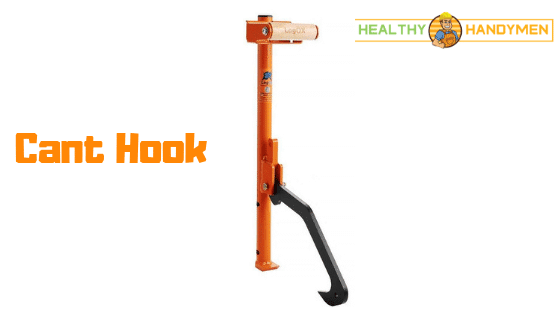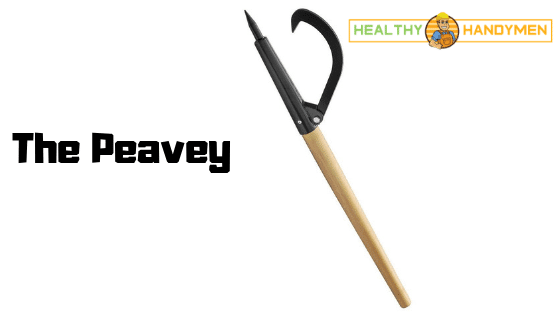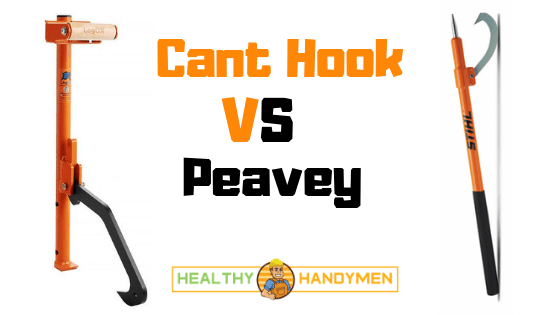We can all agree that logger’s tasks are impossible to perform if you lack the right tools. During a logging project, a lot of lifting, hauling, and moving takes place; and having a peavey or a cant hook can make your work much more comfortable.
For the dedicated woodworker, choosing between these tools can be challenging. After all, their looks are nearly identical, and they also happen to perform similar functions.
In the majority of cases, the cant and peavey hooks are used interchangeably to ease the workload and get projects completed faster.
Dive in, and let’s do a cant hook vs peavey study. We will also explore the features and functions of each tool; consider your type of logs and the work environment to make it easier for you to choose between the two.
Another must-read: Aviation Snips vs Tin Snips
Cant Hook

This is one of the most crucial logging tools. It is used to move, lift, roll, or pivot logs. When rolling logs over, this tool would be useful in getting them positioned for yarding and cutting. It has two opposing hooks making it easier to grab logs and hold them.
Cant hooks have two main parts, the hook, and the handle. The majority of reliable models have handles made of sturdy and durable materials, such as aluminum, steel, or wood.
The handle length determines how easy it will be to get specific tasks accomplished. The rule of thumb is that the longer the cant hook’s handle, the large the size of the log you can maneuver.
With a long handle, you gain an extended reach. Some woodworkers, however, prefer working with cant hooks whose handles are shorter. You need to ensure that your tool makes work more comfortable and also protects your back from overstraining.
The hook is an integral part because it helps to get a firm grip and roll or turn logs over. Generally, this part is made of a metal-like material, and you need to check the grasping capacities of different products.
Cant hooks have smaller hooks than the peavey, and depending on the length of the handle of your tool, you may not be able to handle large-sized logs. On the bright side, cant hooks provide a better grip on the trunks and tend to be safer to use within organized working environments.
They also offer a better grip on a workpiece because of the teeth-like structure that minimizes sliding.
Best Cant Hooks on Amazon?
- Help in lifting, moving and pivoting logs
- Grabbing and holding logs and positioning them is easier
- Strong grip
- Offer enhanced safety within the organized working environments
- May not be best for working on large-sized logs
- May not be ideal for all kinds of woodworking environments
Another interesting read: Mallet Vs Hammer
The Peavey

Similar to a cant hook, peaveys have two main parts, which include the lever handle and the pivoting metal hook. However, they do not have a gripper foot but instead, have a protruding spike. Peaveys are essential logging tools and are used for pivoting, moving, and lifting the logs.
When comparing the hook size, the peavey hook is much bigger. With the absence of a gripper foot, peaveys lack a firm grip on logs so it can be dangerous to use them if you lack the right skills.
On the bright side, this straight protruding hook makes it easier to use the tool within chaotic work environments.
Even though peaveys are not as highly used as cant hooks, they remain a vital tool within the logging industry. They are a darling to tree care specialists, sawmill operators, trail crews, and arborists among other professionals.
There are several perks that this tool has over the cant hook. First, you can stick the protruding hook in the ground. This means peaveys come in handy when you need visual markers when felling trees. Additionally, you can stick the hook between logs and free them for easier moving or lifting.
Modern-day peaveys are available in a range of styles and size options. To make this invaluable tool handier, mastering some tricks of the trade is essential.
Some of the techniques you can use during logging projects include the razorback roll, three-point roll, cross haul, pop, and the pickaroon hold that help to adjust and lift the end of a log when working alone.
Best Peaveys on Amazon?
- Unmatched versatility
- Ideal for using in all sorts of woodworking environment
- A range of techniques can be used to make logging projects easier
- Can serve as a visual marker when felling trees
- Helps to free log stacks for easy moving and lifting
- The grip on logs is not firm
Cant Hook vs Peavey: Which One is the Best?
Seasoned loggers can use both tools interchangeably. If you need to choose between the two, the best one for your needs will highly depend on your work environment.
If the logs within your workplace are neatly piled up, then you may find it more convenient to use a cant hook. In case you have all manner of obstacles around you that make it challenging to handle the logs efficiently, utilizing the peavey would make better sense.
Peaveys allow you to pry between stacks of logs. Within a chaotic environment, sticking the spike of your peavey in the ground will reduce the need to bend over, and this should enhance your safety. You could even use the tool to stop logs from rolling over.
With that said, you should look beyond your personal preferences before deciding which one is better between the peavey and the cant hook. Consider your needs, your logging expertise, and of course, your working environment.
Even though I often find myself using the cant hook, I cannot claim that it is better than the peavey. In all honesty, both tools are invaluable, and I use them interchangeably depending on my project needs.
Final Words
It’s time for us to wrap up the cant hook vs. peavey debate. We have compared both tools, and it is evident that their difference is quite subtle. The seasoned logger is likely to use whichever tool is within easy reach.
To get it right, analyze the state of your working space and put your needs into perspective. Also, think about your preferences and decide whether you need to have a secure grip on your tool or not. Better still, consider having both tools and using them interchangeably during your logging projects.







